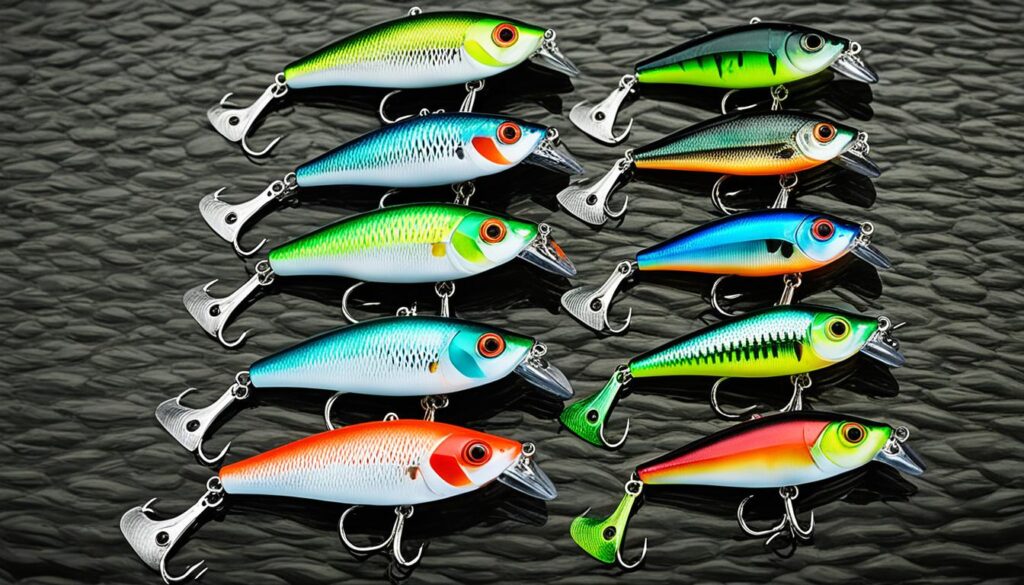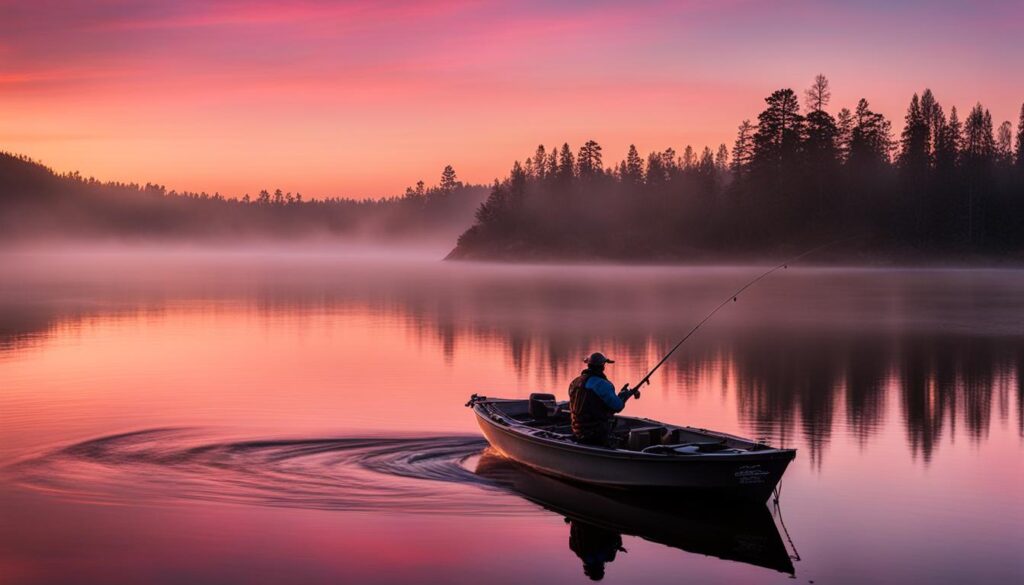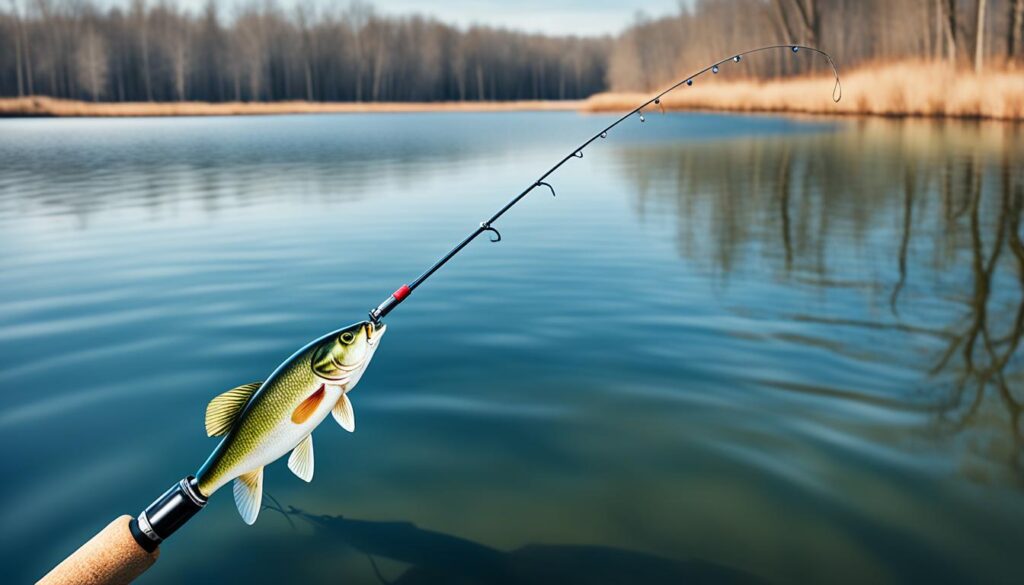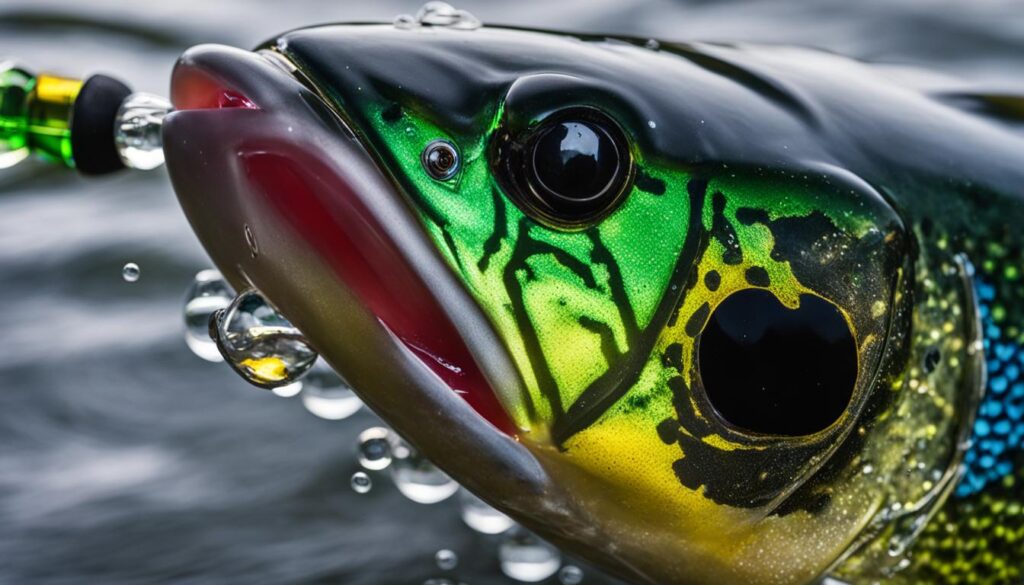When it comes to targeting prespawn bass in grass lakes, one of the most effective lures to have in your arsenal is the lipless crankbait. Designed to mimic the movement of injured baitfish, lipless crankbaits are highly versatile and can quickly locate and entice active prespawners. Whether you’re a beginner or an experienced angler, lipless crankbaits are easy to use and excel at fishing through grass, making them the go-to choice for early spring bass fishing.
To ensure successful fishing with lipless crankbaits, it’s crucial to select the right bait. The weight of the bait is essential for controlling the depth, with 1/2 to 3/4 ounce being the preferred weight range. Two popular lipless crankbait brands known for generating bites are the Savage Gear Fat Vibe and the Savage Gear TPE Soft Vibe.
Boat positioning and making clean casts are also key factors in catching prespawn bass with lipless crankbaits. By positioning your boat strategically along grasslines and irregularities like points and pockets, you can significantly increase your success rate.
Key Takeaways:
- Choose lipless crankbaits for targeting prespawn bass in grass lakes.
- Use 1/2 to 3/4 ounce lipless crankbaits for better depth control.
- Popular brands for lipless crankbaits include Savage Gear Fat Vibe and Savage Gear TPE Soft Vibe.
- Position your boat along grasslines, points, and pockets for better chances of catching prespawners.
- Make clean casts to maximize your success rate with lipless crankbaits.
Selecting the Right Lipless Crankbait
When it comes to lipless crankbait fishing techniques, selecting the right bait can make all the difference. Here are some factors to consider:
Weight:
Opt for a weight in the 1/2 to 3/4 ounce range for better depth control. This allows you to effectively target different water depths and cover more water during your fishing trips.
Brand:
There are several top lipless crankbait brands that have proven their effectiveness in the fishing community. Some popular brands include:
- Savage Gear
- Cordell
- BOOYAH
- 13 Fishing
These brands offer a wide range of lipless crankbaits with different designs, colors, and features to suit different fishing conditions.
Color:
Color choices should be based on the prevailing conditions and the preferences of the bass in your specific fishing location. Different colors can mimic different baitfish species and attract the attention of the bass. Experiment with different colors to determine what works best in your fishing area. Here are some popular lipless crankbait colors:
- Black
- Gold-chrome
- Hot red
- Hot orange
- Baitfish imitations
By selecting the right lipless crankbait, you can increase your chances of success on the water. Keep in mind the weight, brand, and color, and experiment with different combinations to find the perfect bait for your fishing adventures.
Fishing Techniques for Lipless Crankbaits
When it comes to using lipless crankbaits, mastering the right fishing techniques is key to maximizing your success on the water. By understanding how to manipulate these lures effectively, you can entice more strikes from prespawn bass. Here are some proven strategies to help you make the most of your lipless crankbait fishing:
- Ripping Grass on the Upswing:
- Generating Bites on the Fall:
- Yo-Yo Retrieve:
- Long Rod with Moderate Taper:
- Experiment with Retrieve Speeds and Depths:
- Vary the Speed and Cadence:
One effective technique is to rip the lure through grass on the upswing. By pulling the bait quickly through vegetation, you create a burst of action that can trigger a reactive strike from nearby bass.
Another successful approach is to let the lipless crankbait fall after ripping it. The sinking motion mimics a wounded baitfish, enticing bass to strike as they mistake it for an easy meal.
Master the yo-yo retrieve technique by rapidly reeling in the crankbait, then allowing it to drop back down, imitating the movement of injured prey. This erratic motion can provoke aggressive bites from prespawn bass.
Using a long rod with a moderate taper provides several advantages. It allows for longer casts, enabling you to reach fish in distant areas. Additionally, the flexibility of the rod helps clear grass from the lure, reducing the chances of fouling and enhancing your hookset.
Don’t be afraid to experiment with different retrieve speeds and depths to find what triggers the most bites. Bass can display varying preferences depending on the conditions, so testing out different approaches can help you dial in the most effective presentation.
Adding variety to your retrieve can often entice more strikes. By altering the speed and cadence of your retrieve, you create a different action and sound that can be more appealing to prespawn bass.
Remember, successful lipless crankbait strategies involve a balance of technique, experimentation, and observation. By honing your skills and adapting to the conditions, you can increase your chances of landing more bass during the prespawn period.
To further visualize lipless crankbait fishing techniques, take a look at the video below:
Lipless Crankbait Fishing Techniques – Tips and Tricks
This informative video provides valuable insights and tips from experienced anglers on how to effectively use lipless crankbaits for bass fishing during the prespawn period. Watch and learn new strategies to enhance your fishing game.
Best Lipless Crankbait Colors

Choosing the right color for your lipless crankbait can greatly impact your success rate. Here are some popular colors to consider:
Black: A versatile color that works well in various water conditions and is especially effective in low light or murky water.
Gold-chrome: This flashy color mimics the appearance of shad or baitfish, making it a go-to choice for enticing strikes.
Hot red: In colder water temperatures, red-hued colors can trigger a feeding response from prespawn bass.
Hot orange: Another color that excels in colder water, hot orange stands out and grabs the attention of bass.
Baitfish imitations: Using crankbaits that mimic the natural colors of local baitfish can fool wary bass into striking.
When selecting a color, it’s essential to match it to the prevailing water conditions. Consider factors such as water clarity and the type of vegetation present. In colder water temperatures, red-hued colors and baitfish imitations tend to be more effective. In warmer water, brighter colors and chrome finishes can attract more bites.
Experimentation and observation are key to determining the most productive color patterns for your fishing area. Keep an eye on what other anglers are using and pay attention to any patterns or trends. Remember, the best color can vary from day to day, so be willing to switch it up if you’re not getting bites.
Color Recommendations from Professional Anglers
Experienced anglers like Major League Fishing (MLF) pro Stetson Blaylock suggest that black and gold-chrome are their go-to colors for lipless crankbaits. These colors have consistently produced results for them in various fishing scenarios.
Sources:
- Blaylock, S. (2021). Personal communication, February 12, 2021.
| Lipless Crankbait Color | Recommendation |
|---|---|
| Black | Effective in low light or murky water. |
| Gold-chrome | Mimics the appearance of shad or baitfish. |
| Hot red | Triggers a feeding response in colder water. |
| Hot orange | Stands out and grabs the attention of bass. |
| Baitfish imitations | Mimics local baitfish and fools wary bass. |
Boat Positioning and Casting Techniques
When it comes to fishing with lipless crankbaits and targeting prespawn bass, boat positioning and accurate casting play a crucial role in your success on the water. To maximize your chances of landing a bass, it’s important to position your boat strategically and make clean casts along certain features that attract prespawn bass.
Boat Positioning
One key aspect of boat positioning is getting close to grasslines, irregularities, and prespawn areas such as points and pockets. These areas often serve as prime feeding and staging locations for prespawn bass. By positioning your boat near these features, you increase your chances of encountering active fish.
When approaching grasslines, it’s essential to maintain a safe distance to prevent spooking the bass. Position your boat just far enough to make accurate casts while staying within casting range of the desired area. This allows you to cover more water effectively and increase your chances of enticing a strike.
Casting Techniques
Accurate and precise casting is vital for successfully fishing with lipless crankbaits. The ability to place your lure near potential targets and cover is key to triggering strikes from prespawn bass. Here are some casting techniques to consider:
- Long Casting: Utilize a long casting rod to achieve maximum distance. This allows you to cover a larger area and reach bass that might be holding at some distance from the boat. A rod with a moderate taper is recommended as it provides better leverage for solid hooksets and helps clear grass from the lure during the retrieve.
- Pitching and Skipping: When fishing around specific targets such as stumps, docks, or vegetation, mastering the pitching and skipping techniques can be highly effective. These methods enable you to place your lure precisely in hard-to-reach areas where bass tend to hide.
- Precision Casting: As you approach grasslines and other target areas, focus on making accurate casts along these features. Aiming for specific spots where bass may be holding, such as openings in the grass or points, can increase your chances of enticing a strike.
Remember to retrieve your lipless crankbait smoothly and steadily, keeping it at the desired depth and mimicking the behavior of injured baitfish. By mastering boat positioning and casting techniques, you’ll be well-equipped to effectively target prespawn bass and increase your chances of landing that trophy fish.
Fishing Prespawn Bass During Cold Fronts

Fishing during cold fronts in the prespawn period can present challenges for anglers, but with the right strategies, you can still have success targeting bass. When the air temperatures drop and high-pressure systems move in, bass tend to move from shallow areas to deeper spots such as ditches and creek arms. To maximize your chances of catching prespawn bass during cold fronts, here are a few tips:
- Utilize a yo-yo retrieve: One effective technique for triggering bites from prespawn bass is using a yo-yo retrieve with a lipless crankbait. On the upswing, rip the bait through the grass and vegetation, and on the fall, generate bites with a subtle presentation. This imitates wounded baitfish and can entice reluctant fish to strike.
- Use the right gear: A long rod with a moderate taper is recommended for better leverage and accurate casts. Pair it with a casting reel that has a moderate gear ratio, around 6.3:1, to provide more control over your bait. This gear setup will allow you to make long casts and effectively work the bait through the cover.
- Select the right line: To ensure a solid hookset when a fish strikes, it’s important to use a fluorocarbon or low-stretch line. The low stretch of these lines helps transmit sensitivity and allows for better hook penetration. Consider using a line strength of 15-20 pounds, depending on the size of the fish you’re targeting.
Example Prespawn Bass Fishing Gear Setup:
| Rod | Reel | Line |
|---|---|---|
| 7’2″ medium-heavy power, moderate taper casting rod | Medium gear ratio (6.3:1) casting reel | 15-20 pound fluorocarbon or low-stretch line |
By adjusting your techniques and gear to the conditions brought on by cold fronts during the prespawn period, you can increase your chances of landing quality bass. Remember to experiment with different retrieve speeds, depths, and color patterns to find what works best in your fishing area. Stay patient and observant on the water, as this will help you refine your approach and make the most of your time spent fishing in early spring.
Best Times and Locations for Prespawn Bass Fishing

The prespawn period is a crucial time for catching bass, and understanding when and where to target them can greatly increase your success rate. The timing of the prespawn varies depending on the location, so let’s explore the best times and locations for prespawn bass fishing.
In Florida, the prespawn can start as early as January and extend into March. In most of the South, you’ll typically find the prespawn occurring in February and March. Northern states may see the prespawn start as early as March and be in full swing by May. These timelines are influenced by water temperature and other environmental factors.
To target prespawn bass, focus on areas that provide cover and structure during this transitional period. Grass flats, hard spots on mud flats, rocky points, and near spawning areas are all prime locations. Bass use these areas to stage and feed as they prepare to move to their spawning grounds.
Now that you know the best times and locations, it’s time to implement successful lipless crankbait strategies for prespawn bass fishing.
| Location | Timing |
|---|---|
| Florida | January to March |
| South | February to March |
| Northern States | March to May |
Table: Best Times for Prespawn Bass Fishing in Different Locations
Presentation Techniques for Lipless Crankbaits
The presentation of the lipless crankbait is crucial in enticing strikes from prespawn bass. To effectively use lipless crankbaits, consider factors such as depth, water temperature, and the presence of grass or other vegetation. By choosing the right bait and employing different techniques, you can improve your chances of success.
Selecting the Right Lipless Crankbait Brand
When it comes to top lipless crankbait brands, two popular choices are the Cordell Super Spot and the BOOYAH Hard Knocker. The Super Spot is known for its resistance and ability to retrieve over shallow grass, while the Hard Knocker offers a tighter vibration and is suitable for faster and deeper retrieves or lift-drop techniques.
Experiment with Different Retrieve Speeds and Techniques
To determine what triggers the most bites in your fishing area, it’s essential to experiment with different retrieve speeds and techniques. Varying your retrieve speed and cadence can help entice more strikes from prespawn bass. Try steady retrieves, stop-and-go retrieves, or even a yo-yo retrieve to mimic wounded baitfish and trigger reaction bites.
Lipless Crankbait Presentation Techniques
| Technique | Description |
|---|---|
| Ripping Through Grass | Use an upward snap of the rod tip to rip the lipless crankbait through grass. This technique can attract bass hiding in the vegetation. |
| Fast and Deep Retrieves | For faster retrieves targeting deeper areas, opt for the BOOYAH Hard Knocker or similar lipless crankbaits with a tighter vibration. |
| Lift-Drop Techniques | Experiment with lift-drop techniques by raising the rod tip to bring the lipless crankbait closer to the surface and then allowing it to fall naturally. This can imitate a dying or wounded baitfish, enticing nearby bass. |
By incorporating these presentation techniques and using the recommended lipless crankbait brands, you can enhance your chances of catching more prespawn bass. Remember to adapt your approach based on the prevailing conditions and the specific preferences of the bass in your fishing area.
Tackle Selection for Lipless Crankbait Fishing
When it comes to fishing with lipless crankbaits, selecting the right tackle is crucial for success. Here are some key considerations for choosing the right gear:
Rod: Opt for a fairly stiff graphite rod with a medium-heavy power and fast action. This type of rod will allow you to snap the bait cleanly through grass and vegetation, making it easier to fish effectively.
Reel: Pair your rod with a casting reel that has a moderate gear ratio, preferably around 6.3:1. This gear ratio provides better control over your bait and allows for smooth retrieves.
Line: Use a low-stretch line such as fluorocarbon or braid to ensure a solid hookset and to prevent the bait from sinking into the grass. For lipless crankbait fishing, recommended line strengths are 17-pound fluorocarbon or 30-50-pound braid.
To summarize:
| Component | Recommended |
|---|---|
| Rod | Fairly stiff graphite with medium-heavy power and fast action |
| Reel | Casting reel with a moderate gear ratio (around 6.3:1) |
| Line | Low-stretch line such as fluorocarbon or braid (17-pound fluorocarbon or 30-50-pound braid) |
By using the right tackle, you’ll be well-equipped to fish with lipless crankbaits and increase your chances of landing those elusive prespawn bass.
Success Stories and Tip Videos
Many anglers have experienced great success using lipless crankbaits for prespawn bass fishing. One of the pro anglers who has shared valuable tips and techniques is Stetson Blaylock. In his videos, Stetson demonstrates various lipless crankbait fishing techniques that he has personally found effective in targeting prespawn bass.
“When fishing with lipless crankbaits during the prespawn period, I like to focus on areas with grass flats and hard spots on mud flats. These spots tend to attract bass during their transition from winter patterns to the pre-spawn phase. Using a lipless crankbait allows me to cover a lot of water quickly and locate active bass.”
– Stetson Blaylock
Another pro angler who shares his expertise is Jason Christie. In his videos, Jason provides prespawn bass fishing tips that have helped him achieve consistent success using lipless crankbaits. He offers insights into boat positioning, lure presentation, and effective fishing techniques.
“One key tip for fishing with lipless crankbaits is to make accurate casts along grasslines, irregularities, and prespawn areas like points and pockets. These areas are prime locations where prespawn bass tend to gather, especially when they are actively feeding.”
– Jason Christie
Watching videos and learning from experienced anglers like Stetson Blaylock and Jason Christie can provide you with valuable insights and strategies for using lipless crankbaits effectively. By incorporating their tips and techniques into your own fishing approach, you can increase your chances of success when targeting prespawn bass.
Conclusion
In conclusion, lipless crankbaits are incredibly versatile lures that can greatly enhance your chances of catching prespawn bass. To maximize success, it is important to select the right lipless crankbait based on factors such as weight, color, and brand. Experiment with different options to find what works best in your fishing area.
Equally important are the fishing techniques employed when using lipless crankbaits. Ripping through grass on the upswing and generating bites on the fall can be highly effective strategies. Don’t be afraid to vary your retrieve speed and depth, as different bass may respond to different presentations. Practice and observation on the water will help refine your techniques and improve your lipless crankbait fishing skills for prespawn bass.
Finally, it’s crucial to understand the best times and locations for prespawn bass fishing. Targeting areas with grass flats, hard spots, and near spawning areas can significantly increase your chances of landing a bass. Additionally, watching tip videos and learning from experienced anglers can provide valuable insights and strategies. By combining all these elements – proper lure selection, effective fishing techniques, and strategic fishing locations – you can greatly increase your success in lipless crankbait fishing for prespawn bass.
FAQ
What are some lipless crankbait tips for catching prespawn bass?
Lipless crankbaits are highly effective lures for targeting prespawn bass in grass lakes. Professional bass angler and lure designer Cliff Pace recommends using lipless crankbaits for quickly locating and catching active prespawners. These baits can be fished fast and excel at fishing through grass, making them ideal for early spring bass fishing.
How do I select the right lipless crankbait?
When selecting a lipless crankbait, consider the weight, color, and brand. Opt for a weight in the 1/2 to 3/4 ounce range for better depth control. Some top lipless crankbait brands include Savage Gear, Cordell, BOOYAH, and 13 Fishing. Color choices should be based on the prevailing conditions and the preferences of the bass in the specific location.
What fishing techniques should I use with lipless crankbaits?
Fishing with lipless crankbaits involves techniques such as ripping grass on the upswing and generating bites on the fall. Use a yo-yo retrieve to mimic wounded baitfish and trigger reaction bites from prespawn bass. Experiment with different retrieve speeds and depths to find what the bass are responding to.
What are the best lipless crankbait colors to use?
Choosing the right color for your lipless crankbait can make a big difference in your success rate. Some popular colors include black, gold-chrome, hot red, hot orange, and baitfish imitations. Match the color to the prevailing water conditions, such as clarity and vegetation type. Experimentation and observation are key to determining the most productive color patterns for your fishing area.
What are some boat positioning and casting techniques for fishing with lipless crankbaits?
Boat positioning and making accurate casts are crucial when fishing with lipless crankbaits. Position the boat close to grasslines, irregularities, and prespawn areas such as points and pockets. Clean casts along these features increase your chances of landing a bass.
How can I fish for prespawn bass during cold fronts?
Fishing during prespawn cold fronts can be challenging, but lipless crankbaits can still be effective. Utilize a yo-yo retrieve with the lipless crankbait, ripping through grass on the upswing and generating bites on the fall. Use a long rod with a moderate taper and a casting reel with a moderate gear ratio for better leverage and long casts.
What are the best times and locations for prespawn bass fishing?
The timing of the prespawn period varies depending on the location. Target prespawn bass in areas with grass flats, hard spots on mud flats, rocky points, and near spawning areas. These areas provide bass with the necessary cover and structure during the transition period from winter patterns to the pre-spawn phase.
What presentation techniques work well with lipless crankbaits?
The presentation of the lipless crankbait is crucial in enticing strikes from prespawn bass. Factors such as depth, water temperature, and the presence of grass or other vegetation influence the choice of bait. Experiment with different retrieve speeds and techniques to find what triggers the most bites in your fishing area.
What tackle should I use for lipless crankbait fishing?
Selecting the right tackle is important for effectively fishing with lipless crankbaits. Use a fairly stiff graphite rod with a medium-heavy power and fast action to snap the bait cleanly through grass and vegetation. Pair it with a casting reel with a moderate gear ratio, around 6.3:1, for better control. Fill the reel with a low-stretch line, such as fluorocarbon or braid, to ensure a solid hookset and to prevent the bait from sinking into the grass.
Are there any success stories or tip videos available for lipless crankbait fishing?
Many anglers have experienced success using lipless crankbaits for prespawn bass fishing. Successful pro anglers like Stetson Blaylock and Jason Christie have shared their tips and techniques in videos to help other anglers improve their fishing skills. Watching videos and learning from experienced anglers can provide valuable insights and strategies for using lipless crankbaits effectively.
What are the key points to remember about lipless crankbait fishing?
Lipless crankbaits are versatile lures that can be highly effective for catching prespawn bass. By selecting the right lipless crankbait, using proper fishing techniques, and understanding the best times and locations for prespawn bass fishing, anglers can increase their chances of success. Experiment with different colors, retrieve speeds, and presentation techniques to determine what works best in your fishing area.
